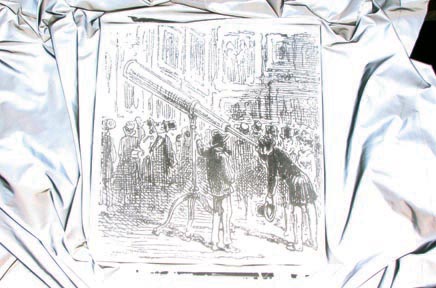Gallery One, Chicago

In the “The Lightweight”, the signature work in JOSÉ LERMA’s first solo show at Western Exhibitions, Lerma screenprinted a cartoon, in varnish, on a section of a large reflective curtain (1) that is stretched to look like a painting, an image that can only be seen when one is in-line with the light source. The cartoon, from the French satirical newspaper Le Charivari in 1880, refers to the Salon Exhibition of that year; its translated caption reads: A painter whose work is badly placed installed a telescope so that art lovers can see his picture for two sous (2) …which he gladly gives them.
The telescope in the cartoon image points toward a section of the reflective curtain where Lerma has affixed colorful cut-out circles taken from his old sweaters that are ridden with moth-holes (3). This image and organization of painting materials piqued Lerma’s interest in the idea, that at the time of the Salon, reputation (prestige) and physical placement of a work were the same thing, of which Lerma equates with the contemporary idea of credentialism.
Lerma continues to expand upon his already expansive vision of painting for the second piece in the show, titled “Rampant Mid-Careerism”, by stretching a Vietnam-era training parachute over several blank canvases that are hung salon-style and a larger photograph of a painting. A larger canvas with the text Lord Landsdowne (4) scribbled on it in large blue letters, also wrapped within the parachute, rests on a synthesizer, set to arpeggio-mode, playing random glass harmonica (5) sounds.
“The Lightweight” runs in Gallery 2 at Western Exhibitions, located in Chicago’s West Loop gallery district, from April 8 to May 14. José Lerma’s recent solo show at Andrea Rosen Gallery in New York was reviewed in Artforum.com and he has shown at the Museum of Fine Arts, Houston; the Milwaukee Art Museum; El Museo del Barrio, NY; the Museum of Contemporary Art, Detroit; and the Institute of Puerto Rican Culture, and he has shown internationally with recent solo gallery exhibitions in Seoul, Berlin and Madrid. Lerma was born in Spain and raised in Puerto Rico, studied political science at Tulane and law at the University of Wisconsin, Madison, before switching his major to art and earning his MFA. He was granted a year-long residency in Puerto Rico, attended Skowhegan School of Painting and Sculpture, and the CORE Program (affiliated with the Museum of Fine Arts in Houston, TX). José Lerma lives and works in New York and Chicago, where he is on faculty at the School of the Art Institute of Chicago.
(1)
The reflective fabric, made by 3M, is used for night safety. The curtain is a classic motif for many painters (Richter’s gray curtains for example) due to the story of Parrhasius and Lerma is interested in reversing its function (light suppression) to, if not light emission, a hyper-reflection. This idea of being aligned with light picks up on a parallel narrative to a strand of positivist ideas in art and painting in particular. States Lerma: “The curtains can go from dull, to sublime, to cheap depending on one’s physical relation to it…that is my favorite quality about them.”
(2)
The sous, or solidus, is a pure gold coin weighing 1/60th of a pound, introduced by Diocletian around 301 AD. By 1880 in France, the term had come to mean an almost worthless coin.
(3)
Moths live, and often die, for the pursuit of light. They also eat the proteins of foodstains in our garments. The moth-holes in Lerma’s sweaters have been blown up and turned into abstractions.
(4)
Lord Landsdowne was a professional wrestler who was the first to truly combine sports and theater. Originally from Ohio, he began dressing as an English lord in the 1920s, was accompanied to the ring by two valets and was the first to use a soundtrack when entering the ring.
(5)
The Glass Harmonium sound was invented by Benjamin Franklin and in the 18th and early 19th century, it was believed to induce madness. Because of its frequency, it is difficult to locate the sound of the Glass Harmonica spatially.